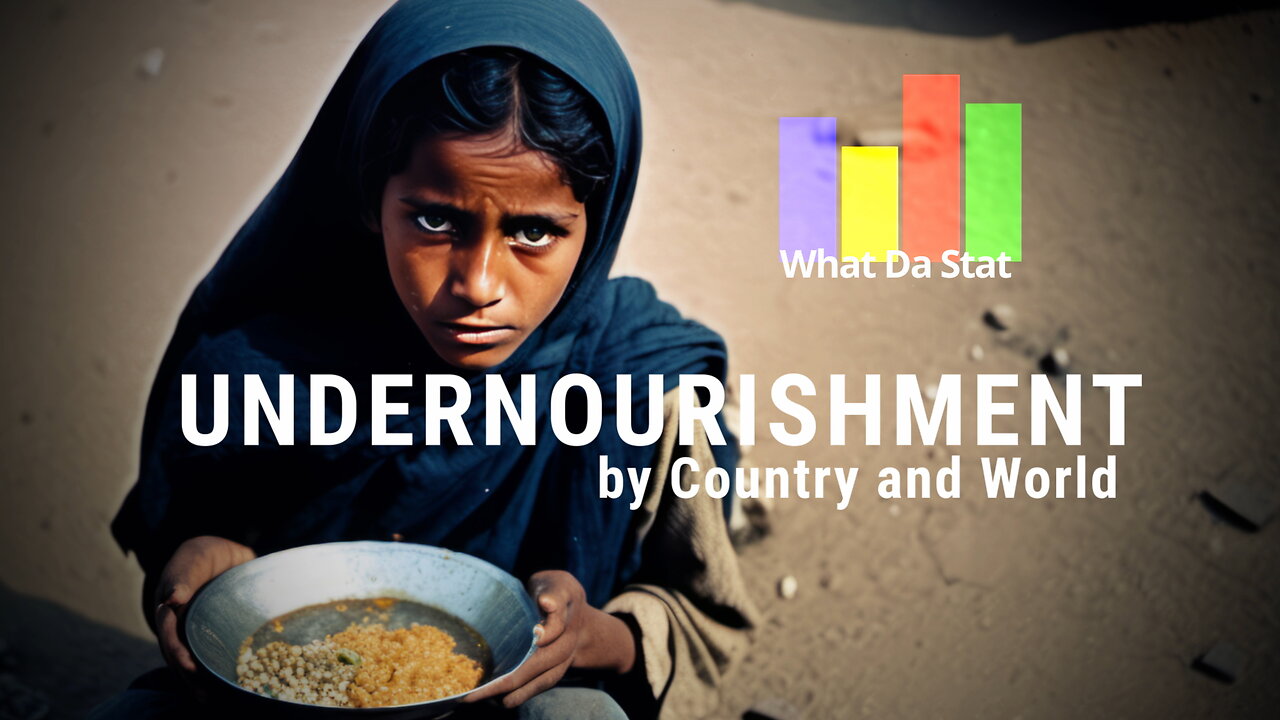Premium Only Content

Undernourishment by Country and World 2001-2020
This video shows the prevalence of undernourishments in percentage of countries, regions and world population from 2001 to 2020.
Undernourishment, a persistent global issue, refers to a condition where individuals do not receive sufficient nutrients and calories to maintain a healthy and active life. This problem has been a major concern both at the international level and within individual countries, with significant developments occurring between 2001 and 2020.
Global Trends (2001-2020):
Progress and Setbacks: The period from 2001 to 2020 witnessed both progress and setbacks in the fight against undernourishment. Initially, there were some positive trends, with the number of undernourished people globally declining. This was partly due to economic growth and increased agricultural productivity in many regions.
Global Economic Crisis: The global economic crisis of 2008 had a negative impact on efforts to combat undernourishment. It led to rising food prices, making it difficult for vulnerable populations to access essential nutrition.
Climatic Challenges: Climatic events is a significant factor affecting food security during this period. Erratic weather patterns, such as droughts and floods, disrupted agricultural production and food distribution, exacerbating undernourishment in vulnerable regions.
Conflicts and Displacement: Conflicts and displacement, particularly in the Middle East and Africa, contributed to food insecurity. Millions of people were forced to leave their homes, leading to increased vulnerability to undernourishment.
Global Initiatives: International organizations, such as the United Nations' Sustainable Development Goals (SDGs), set targets to eliminate hunger by 2030. Various initiatives, including the Scaling Up Nutrition (SUN) movement, aimed to coordinate efforts to combat undernourishment at the global level.
Country-Specific Trends (2001-2020):
Sub-Saharan Africa: Many countries in Sub-Saharan Africa continued to face significant challenges related to undernourishment. Factors such as population growth, poor infrastructure, and conflict often hindered progress in this region.
Asia: Several Asian countries made substantial strides in reducing undernourishment. Countries like China and India saw improvements due to economic growth, increased agricultural production, and targeted government programs.
Latin America: Some Latin American countries, like Brazil, implemented successful social programs that reduced undernourishment. However, disparities persisted within and between countries.
Middle East: Political instability and conflict in the Middle East, particularly in Yemen and Syria, led to severe food insecurity and undernourishment among affected populations.
Eastern Europe and Central Asia: Many countries in this region faced challenges in transitioning to market-based economies, affecting food security for vulnerable groups.
In summary, from 2001 to 2020, undernourishment remained a complex and persistent issue, with progress in some regions and setbacks in others. Global economic events, climate change, conflicts, and displacement played significant roles in shaping the prevalence of undernourishment during this period. Efforts were made at both global and national levels to combat this problem, but achieving food security for all remained a formidable challenge.
Data source: FAO/UN
Music:
Punch Deck - Under the Stars
https://www.youtube.com/c/PunchDeck
https://open.spotify.com/artist/7kdduxAVaFnbHJyNxl7FWV
https://punchdeck.bandcamp.com/
https://soundcloud.com/punch-deck
https://www.instagram.com/punchdeckofficial/
https://twitter.com/punch_deck/
Data visualization created with flourish.studio and AI
-
 LIVE
LIVE
Badlands Media
9 hours agoBadlands Daily: August 29, 2025
3,173 watching -
 39:49
39:49
Randi Hipper
57 minutes agoBITCOIN BULL MARKET ENDING EARLY? PRICE UPDATE
30 -
 LIVE
LIVE
Total Horse Channel
3 hours ago2025 Gypsy Congress Championship Show | Friday
125 watching -
 LIVE
LIVE
Matt Kohrs
9 hours agoMarket Open Chaos: PCE Inflation Report & Payday Friday || Live Trading
706 watching -
 17:35
17:35
itsSeanDaniel
1 hour agoPro-Transgender Doctor HUMILIATED by Genius Conservative
6.91K9 -
 LIVE
LIVE
GritsGG
2 hours agoWin Streaking! Most Wins 3499+ 🧠
39 watching -
 LIVE
LIVE
Wendy Bell Radio
5 hours agoCrime is a 99/1 Issue
7,043 watching -
 1:07:12
1:07:12
Crypto Power Hour
3 hours ago $0.47 earnedBlockchain, The Fifth Evolution of Computing
13.4K6 -
 LIVE
LIVE
LFA TV
4 hours agoLFA TV ALL DAY STREAM - FRIDAY 8/29/25
3,731 watching -
 1:15:29
1:15:29
JULIE GREEN MINISTRIES
3 hours agoTHE GREAT WHITE WOLF NEXT TO YOUR PRESIDENT WILL SOON BE UNMASKED
86.9K195